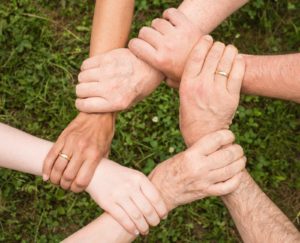
By Grace Chen Yu, MD
In 10 weeks, COVID has changed our world. Just as the post-911 world found us complying with airport shoe removal, liquid limits to 3oz or less, and drop-offs at the curb, our current pandemic has brought words like social distancing, PPE, and shelter in place into our everyday vocabularies. When my six-year old daughter knows enough to call out every morning that I leave for work, “Bye, Mommy! Stay safe!” - I know that her world has forever changed. Not all for the worse, however. If you had told me 6 months ago that we and our fellow global citizens would now be waging a war against an invisible common threat - an incredibly contagious novel coronavirus, I would have laughed that this was the stuff of Hollywood. Well, no more. I stand corrected.
During the early weeks of the pandemic, as a family physician and residency director in Santa Clara County, the first location in the country declared a coronavirus “hot spot” by the lay press, things were happening so quickly that that there was no time to sit and reflect about what was happening to us. We mobilized to set up an organizational chain of command and communication strategy that would keep us informed and updated about policies that changed not by the week or day, but often by the hour. There was no “pandemic” guide that we followed, just common sense and the collective wisdom of our faculty and Santa Rosa colleagues who had unfortunately worked through the large-scale natural disaster of the California wildfires that had obliterated their communities two years prior. Their lessons learned pushed us to develop a residency-wide WhatsApp group to share urgent announcements, a residency COVID-19 webpage to serve as a one-stop shop for our policy and workflow updates, and a delegation of roles to ensure that our entire group was well-cared for, from our residency leadership down to our rotating medical students.
Almost overnight it seems, our lives changed. Our local public schools announced a temporary 3-week closure on Friday, March 13, which was later extended to the rest of the academic year. The irony around the date of the announcement did not escape any parent. My children (ages 11, 8, and 6), however, were overjoyed at this early Spring Break. Given the rapid announcement, teachers did not yet have the chance to migrate teaching tools to online platforms, much less create the Distance Learning Plans that are now part of our daily existence. When our local Public Health Officers announced the first Shelter in Place (SIP) orders in the country on March 16, we - like many families - found our children’s afternoon activities come to a grinding halt. The absence of school hours and after-school activities left big swaths of the day suddenly open. My husband, a healthcare investor who travels frequently for work, found himself suddenly grounded, and in the days before his office transitioned to working from home, he took up the slack at home that my longer days at the office had created. Lest video games or TikTok fill our children’s days, he created hour by hour lesson plans for our children that first week - somewhat too enthusiastically, we later discovered when our 6-year old had not yet mastered quadrilaterals by Day 4.
Our parents - definitely in the age range considered “high risk for COVID complications” - managed in different ways. My recently widowed father has been the most fastidious and well-informed self-isolator, and he armed himself at home with a several week supply of food, paper products, and cleaning materials, dutifully reporting over our daily FaceTime check-ins the latest in COVID news (to intentionally save me the time of doing so myself). My husband and I debated what to do about my in-laws, both of whom have moderate cognitive impairment but had been living independently in a home not far from ours before the pandemic. Moving them into our house would not have been easy under normal circumstances. Doing so on a moment’s notice with neither of them having full understanding of the reason behind this sudden change was next to impossible. And would I - who would continue to see patients in the office and hospital, including COVID+ patients - become a liability to them or to my father if we were housed under the same roof? Like most families grappling with similar issues, we ended up with a compromise that had us checking in regularly with them during the week to provide food and necessary supplies and them staying with us on the weekends to develop a bit of “normalcy” and routine. This arrangement involved finding and hiring a caregiver for them - fortunately already in the works before the pandemic - as well as a shift in roles and expectations for all of us.
Our nanny, who had previously spent most of her work hours shuttling our children to and from school and activities and who herself belonged to a high risk age group, transitioned overnight to a mostly live-in nanny who would later take on language schooling for our two youngest children (all three of our children are in bilingual schools), as my husband and I juggled the other aspects of their home education. Patience is one of her strongest virtues, but although she has continued her track record of kindness and equanimity, I am quite certain that her newfound role was one that tested even her greatest strength.
To be honest, in the first few weeks, I was barely present at home. When I wasn’t at the office, my head was on fire creating new workflows and schedules. As quickly as we received new information, those workflows would need to change. Sheltering in place meant that although technically, healthcare facilities would remain open and accessible to our communities, we would need to find alternate ways to provide care that would lower risk of unnecessary exposure to our patients and staff. We scrambled to put into place telemedicine workflows we had learned of but had never actually utilized, and where those modalities were not already present (such as in our residency federally qualified health center serving Medicaid patients or in our county community hospital), our faculty were unbelievably resourceful in designing strategies to allow our patients to connect to their doctors without a compromise in patient security and safety. By March 18, the same day that Governor Newsom issued SIP orders for the state of California, our faculty had developed from scratch a HIPAA-compliant telemedicine protocol for our residency clinic and we began training our residents, staff, and patients how to use it.
Financial reimbursement for these types of visits was largely unknown at the time, but we all knew it was the right thing to do.
By now, we had read the earlier reports from Wuhan showing a much higher rate of COVID-19 healthcare worker infection than the general public. With so many unknowns about the mode of transmission during the earlier stages of our epidemic, protecting our vital workforce was paramount. I had already experienced firsthand how infection could be unwittingly transmitted; days before stay at home orders had started in Santa Clara and a full week before NYC’s SIP orders, my brother - a retina specialist in NYC - had already come down with the infection. Two days later, one of my residents tested positive. Both had unknowingly spread the infection to their household members – or perhaps it was the other way around. It doesn’t matter much either way, does it? Contact tracing did not reveal an obvious source in either case.
Fortunately, both sets of infections were mild, and everyone recovered without incident. However, the duration of quarantine was weeks long for both (in one case, 3.5 weeks from the time of last symptom to negative test, resulting in a 4+ week time out of direct patient care).
This experience plainly illustrated that if contagion were allowed to spread among our resident teams working in sometimes unavoidably close quarters and under longer working hours than the usual employee, we would soon be facing the same higher healthcare worker infection rate as our colleagues in Italy and China had faced. A reduction in workforce, particularly one that was preventable to some extent through skillful scheduling and well-informed policies, would be terrible enough; a serious illness - or God forbid, a fatality - among our own, simply paralyzing.
Thus, with an alacrity mostly borne out of a shared vision and mission, within ten days of our SIP order, our residency program had
 As family doctors who are well-accustomed to caring for the whole person, we understood that instituting procedures was not enough. We needed to embed our systems with support. It was crucial to attend to not only our professional work assignments, but also importantly, our individual and collective well-being. Zoom Happy Hours, a program-wide Haiku challenge, socially distanced yoga sessions for our residency classes, weekly check-ins for the faculty and residency, and many more suggestions like these all helped to buoy our spirits, as did the enormous outpouring of support we felt from friends both known and unknown to us. This support came to us in the form of some of the most basic necessities in life – food and clothing. Through the power of social media, friends created a GoFundMe campaign to provide lunch for our hardworking providers and staff each day for weeks on end. For weeks, donations of PPE have arrived on my doorstep, while messages in my email inbox have promised ongoing large-scale donations of masks and gowns from friends overseas. When a faculty colleague posted her wish of having tablets to use in the hospital for isolated COVID+ patients to communicate with their loved ones and with their health care teams to conserve PPE supply, the response was overwhelming. In less than a week, iPads secured by our county hospital and through donations from the community began showing up throughout the hospital.
As family doctors who are well-accustomed to caring for the whole person, we understood that instituting procedures was not enough. We needed to embed our systems with support. It was crucial to attend to not only our professional work assignments, but also importantly, our individual and collective well-being. Zoom Happy Hours, a program-wide Haiku challenge, socially distanced yoga sessions for our residency classes, weekly check-ins for the faculty and residency, and many more suggestions like these all helped to buoy our spirits, as did the enormous outpouring of support we felt from friends both known and unknown to us. This support came to us in the form of some of the most basic necessities in life – food and clothing. Through the power of social media, friends created a GoFundMe campaign to provide lunch for our hardworking providers and staff each day for weeks on end. For weeks, donations of PPE have arrived on my doorstep, while messages in my email inbox have promised ongoing large-scale donations of masks and gowns from friends overseas. When a faculty colleague posted her wish of having tablets to use in the hospital for isolated COVID+ patients to communicate with their loved ones and with their health care teams to conserve PPE supply, the response was overwhelming. In less than a week, iPads secured by our county hospital and through donations from the community began showing up throughout the hospital.
It is important to highlight the fact that none of the above would have been possible without contribution from every single member of the team. Residency training requirements compel programs to train and evaluate their learners on several domains, with team communication and acknowledgment of team members’ roles being two of the key domains. We were fortunate to have a strong foundation of teamwork and volunteerism in place before the pandemic struck.
When I first posed the question to our group in early March, “Would you volunteer to be in a pool of healthcare providers taking care of COVID+ patients?” the overwhelming response I received was yes. Those who were precluded from volunteering due to risk factors filled in the gaps everywhere else to allow us to form clinical teams for all of our patients. I would venture a guess that just as systems with pre-existing dysfunctional or lopsided teams might fare more poorly when faced with extreme external stressors, systems built on trust that acknowledged the beneficial contributions of every individual would likely emerge stronger as a result of the shared experience of entering “combat” together.
No system is perfect, however. My own family has had difficult conversations about how we should balance the medical risks of unintentional exposure to my father with the emotional risks of his isolation. There is no easy answer to guide my father, my siblings, or me, and the answer will likely be different in each household. Likewise, among our faculty group – a remarkably cohesive group pre-pandemic, we have had different perspectives about how to approach the care of our patients while mitigating exposure risk to others. We remained aligned in our goal of taking care of our patients and each other and this shared mission pushed us forward. Our situation is not unique. We are not immune to anxiety, stress, depression, or illness. But we are also not immune to the unbelievably powerful effect of optimism and hope, embedded in reality.
As the weeks have passed and it has become increasingly clear that we will not be returning to “normal” anytime soon – or perhaps ever – it is time to embrace our new normal. For our families, for our residency programs, for our healthcare systems, and for our communities, this means moving beyond political polarization, accepting our differences for the unique contributions that they allow, and recognizing our shortcomings that this pandemic has highlighted, while also appreciating the special opportunities that it has afforded us.
For my family, the latter means we have celebrated our first SIP birthday, learned to ride a bike after 5 years of being terrified of falling, reserved time each day to exercise together outdoors, found new ways to be creative and musical, become more involved than ever before in household chores (kids) and school assignments (parents), and talked to neighbors for the first time since moving into our new home 6 months ago.
For my residency program, it means we have found a way to collectively care for over 100 COVID+ patients, celebrate an unforgettable virtual Match Day, deliver well-attended online group visits, diagnose and care for entire family units stricken by COVID-19, and partake in the day to day gifts that our patients present us – a new pregnancy, a child’s first steps, a discussion about what matters most – quality or quantity of life, as they face their own mortality.
For our healthcare system, embedding optimism and hope in our new reality means we should be thinking both broadly and very specifically about how best we can support our most vulnerable populations with stronger public health and social safety systems. We should be planning ways to provide equal access to high-quality medical care separate from employment status. We should be promoting prevention and education above costlier and sometimes less effective treatment and procedures.
 Humankind has a short collective memory of pain. It is a defense mechanism well-suited to helping survivors of calamity move beyond the unimaginable. As we start shifting from emergency response state to something more sustained and less reactive, we would do well not to forget too soon the lessons of this pandemic, lest we diminish the potential upside of the freedoms and lives that we have sacrificed as a society over the last 6 weeks. If we can focus on these silver linings, the COVID-19 pandemic need not go down in history as one of the most widespread periods of public pain to strike the modern era. And my daughter’s early introduction to fear of an invisible enemy will not be all for naught.
Humankind has a short collective memory of pain. It is a defense mechanism well-suited to helping survivors of calamity move beyond the unimaginable. As we start shifting from emergency response state to something more sustained and less reactive, we would do well not to forget too soon the lessons of this pandemic, lest we diminish the potential upside of the freedoms and lives that we have sacrificed as a society over the last 6 weeks. If we can focus on these silver linings, the COVID-19 pandemic need not go down in history as one of the most widespread periods of public pain to strike the modern era. And my daughter’s early introduction to fear of an invisible enemy will not be all for naught.